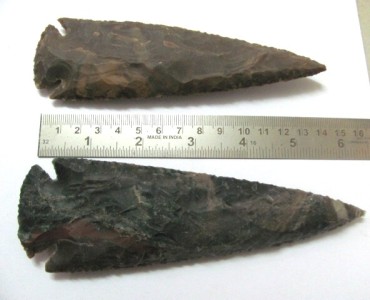25 June 2025
Posted By : Gemstone Export
Arrowheads have long been a symbol of ancient craftsmanship and practical hunting tools. Among the wide variety of materials used to make them, agate arrowheads stand out for their visual beauty and resilience. But how do they compare to other popular stone arrowheads, such as those made from flint, obsidian, or jasper?
This post explores the differences between agate arrowheads and other stone arrowheads, offering insight into their characteristics, historical usage, and collector value. To dive deeper into their origins and cultural importance, visit our complete guide on the history and significance of agate arrowheads.
What Are Agate Arrowheads?
Agate arrowheads are tools or ceremonial objects crafted from agate, a form of microcrystalline quartz known for its colorful banding and durability.
Key characteristics of agate arrowheads:
- Made from naturally banded, often translucent agate
- Valued for their aesthetic appeal and strength
- Commonly used in both ceremonial and functional contexts
- Often polished or shaped for display or spiritual use in modern times
Agate’s hardness (7 on the Mohs scale) made it suitable for shaping, although more challenging to flake than softer stones.
How Agate Compares to Other Stone Arrowheads
Let’s look at how agate holds up against other popular materials used in arrowhead crafting.
1. Flint Arrowheads
- Material Type: Cryptocrystalline form of quartz
- Color: Often gray, brown, or black
- Edge Sharpness: Very sharp edges, easy to flake
- Durability: Less durable than agate
- Common Use: Widely used in prehistoric tools due to ease of shaping
Pros: Easy to shape, sharp edges
Cons: Brittle compared to agate
2. Obsidian Arrowheads
- Material Type: Volcanic glass
- Color: Black or deep green
- Edge Sharpness: Razor sharp, extremely fine cutting edge
- Durability: Very fragile, prone to breaking
- Common Use: Precision tools and ceremonial use
Pros: Sharpest edges among stone tools
Cons: Extremely brittle and fragile
3. Jasper Arrowheads
- Material Type: Opaque variety of quartz
- Color: Earth tones—red, yellow, brown
- Edge Sharpness: Moderately sharp
- Durability: Similar to agate, though less vibrant in appearance
- Common Use: Widely used due to abundance
Pros: Durable, widely available
Cons: Lacks translucence or banding seen in agate
4. Agate Arrowheads
- Material Type: Banded form of chalcedony quartz
- Color: Multicolored with distinctive banding
- Edge Sharpness: Can be sharp but harder to flake
- Durability: Highly durable
- Common Use: Decorative, ceremonial, and collector’s items
Pros: Visually unique, hard and long-lasting
Cons: Difficult to shape by hand due to hardness
Use Cases of Agate and Other Stone Arrowheads
- Hunting Tools: Flint and obsidian were commonly used due to ease of flaking into sharp points.
- Ritual and Symbolic Use: Agate arrowheads, because of their color and uniqueness, were often symbolic.
- Modern Collecting: Today, agate and jasper arrowheads are popular among collectors and spiritual practitioners.
How to Identify Different Stone Arrowheads
To distinguish agate arrowheads from others:
- Color Banding: Agate often shows layered bands or a translucent appearance.
- Surface Texture: Flint and obsidian tend to have more conchoidal fracture marks.
- Weight and Feel: Agate is heavier and smoother compared to other stones.
- Light Test: Hold against light—agate may show some translucence.
FAQs: Agate Arrowheads vs. Other Stones
Q1: Are agate arrowheads better than obsidian arrowheads? Not necessarily better—just different. Obsidian is sharper but much more fragile. Agate is durable and often more valued for its beauty.
Q2: Why were agate arrowheads used if they’re harder to shape? Agate’s durability made it a good long-term tool. It was also prized for ceremonial and symbolic uses due to its appearance.
Conclusion
Agate arrowheads stand apart for their stunning visual patterns and toughness, while flint, obsidian, and jasper each bring unique qualities to the world of ancient tools and modern collecting. Understanding these differences helps collectors and history enthusiasts appreciate each stone’s unique role in shaping human history.
To explore more about the cultural background and symbolic meaning of agate arrowheads, visit the full History and Significance of Agate Arrowheads.
